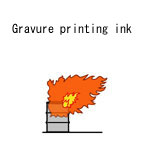| Case Name |
Fire caused due to static electricity near an ink tank of a gravure printing machine |
| Pictograph |

|
| Date |
July 10, 1989 |
| Place |
Tanba, Funai County, Kyoto, Japan |
| Location |
Printing factory |
| Overview |
On July 10th, 1989. A gravure printing machine was being operated at a printing factory, with static electricity removal equipment out of order. Static electricity discharged between a pressurization roller and printed matter, and ink ignited. The storage quantity of a dangerous material exceeded the specified quantity. Moreover, notice to fire department was delayed. |
| Incident |
A fire occurred at a gravure printing machine during operation. As a static electricity removal device was not operating, static electricity sparks occurred, ink near a pressurization roller ignited, and a fire occurred. |
| Processing |
Consumption and usage |
| Substance |
Toluene, Fig2 |
| Gravure printing ink |
| Type of Accident |
Fire |
| Sequence |
On July 10th, 1989. Printing work using a five-color gravure printing machine started.
About 15:15. A fire was found near an ink tank for the fifth color of a printing machine.
The fire could not be extinguished although initial fire extinguishing was attempted with a fire extinguisher and carbon dioxide firefighting equipment.
15:21. An emergency call to the public fire department was made.
15:40. The fire was extinguished.
Three employees suffered from smoke-inhalation. |
| Cause |
The switch of the static electricity removal device of the printing machine was turned off, and wiring of this device was not connected. Static electricity was charged and discharged between a pressurization roller and printed matter. As the fire was at the upper part of the ink tank, an ink solvent of toluene ignited.
Firefighting equipment was installed optionally and check maintenance was entrusted to a subcontractor. As a daily check was not carried out, firefighting equipment was not used effectively. |
| Response |
Initial fire extinguishing was attempted using fire extinguishers and carbon dioxide firefighting equipment. A notice was made to the fire department. |
| Countermeasures |
A new indoor dangerous material storage was established, and quantity handled at one time was reduced to within a specified quantity.
Fire prevention management was carried out properly. |
| Knowledge Comment |
Users of a dangerous material do not fully understand the danger of static electricity in many cases. Probably, education is also important for use (consumption) and manufacture because there is no difference between them on handling a dangerous material. |
| Background |
Equipment and operation management are inadequate. Furthermore, dangerous materials controlled under the Fire Service Law were stored beyond the specified quantity, a report to a fire department was delayed, etc., so it is considered that safety was neglected or knowledge was insufficient. |
| Incidental Discussion |
Oily ink is usually a mixture of pigment and adhesives in toluene. Therefore, handling is the same as that of toluene with a fire hazard. However, users tend to take it easy. |
| Reason for Adding to DB |
Explosion of fire caused due to static electricity during operation of a defective machine |
| Scenario |
| Primary Scenario
|
Poor Value Perception, Poor Safety Awareness, Inadequate Risk Recognition, Organizational Problems, Inflexible Management Structure, Insufficient Education/Training, Ignorance, Insufficient Knowledge, Poor Study, Usage, Maintenance/Repair, Not repaired, Malicious Act, Rule Violation, Safety Rule Violation, Bad Event, Electrical Failure, Static Electricity Electrification, Secondary Damage, External Damage, Fire, Bodily Harm, Sickness, 3 person sickness, Loss to Organization, Economic Loss, Direct Monetary Damage 13 million yen
|
|
| Sources |
Fire and Disaster Management Agency, Major cases of accident, Fire occurred during printing work with a gravure printer near an ink tank. Accident cases of dangerous materials. pp.33, 376-377.
|
| Number of Injuries |
3 |
| Physical Damage |
One set of five color gravure printing machines, workplace eaves, etc. were damaged by fire. Water damage and stain of two color gravure printing machines. Stain of two letterpress color printing machines. Water damage to 60 cylinders and 40 L of toluene. Stain and high-temperature damage to 650 L of ink for gravure printings. |
| Financial Cost |
¥ 13 million. (Accident examples of dangerous materials). |
| Multimedia Files |
Fig2.Chemical formula
|
| Field |
Chemicals and Plants
|
| Author |
ITAGAKI, Haruhiko (Japan National Institute of Occupational Safety and Health)
TAMURA, Masamitsu (Center for Risk Management and Safety Sciences, Yokohama National University)
|
|